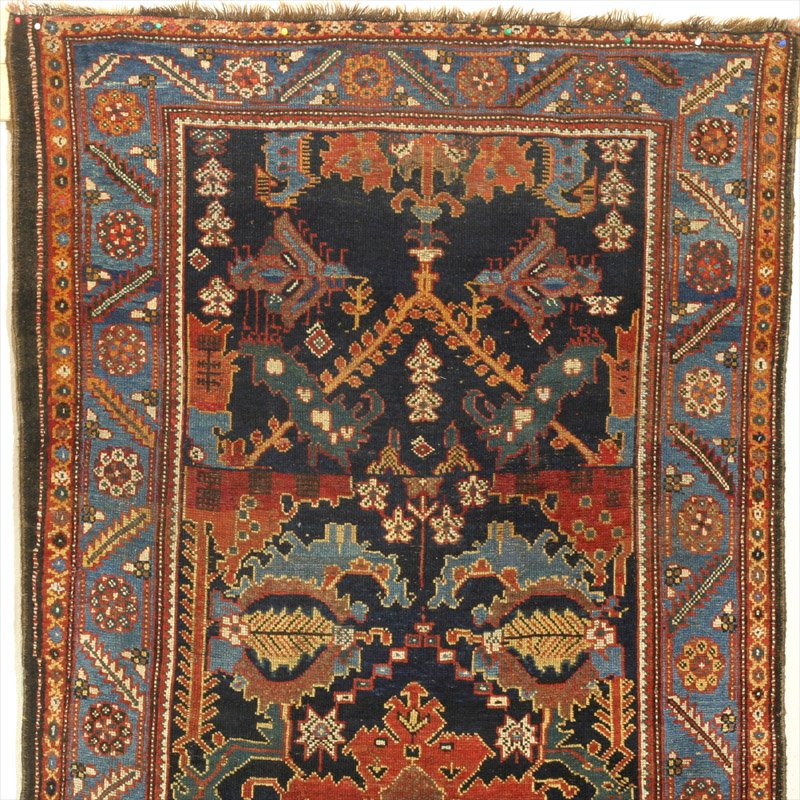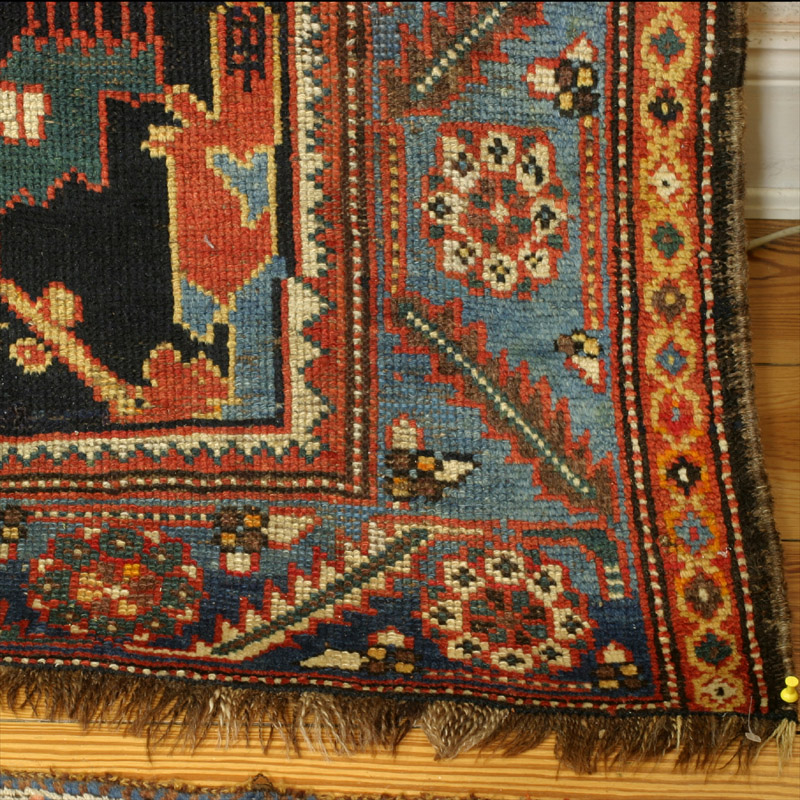Click on image to view at larger size
Or click extra large size (warning: large image!!, 1.63 MB).

First, I just reproduce what Ian Bennett says about this rug:
"An attractive and rare Bakhtiari tribal rug, Chahar Mahal Valley of Fars, west Persia, second half 19th century, 7ft.5in. x 4ft.4in. (2.26m x 1.32m. Slight uneven wear, losses to both ends with both outer guards missing lower end*. With its all wool and goat hair foundation and rich vegetable palette, this is an attractive and unusual example of what is probably pre Chahar Mahal workshop Bakhtiari weaving. A later workshop rug, attributed to Baba Heidar village, with the same main border and a closely related field design, described as 'palmette and dragon', is illustrated in Peter Willborg, Chahar Mahal va Bakhtiar, no. 103, p139. The design is probably derived from a 17th century Kerman 'vase' carpet, which, as a group, probably also served as inspirational models for 'dragon' carpets."
*) This is incorrect—there is just one outer guard.
What do I have to add? There are a few things I find intriguing about the design. First of all, the scale, the HUGE palmette, the boldness of the forms, the strong contrasts, the many quirky details (notice the little grids in the madder shapes two thirds up). Then, the interplay betweeen a set design and the loose, improvised execution. The design is principally symmetrical along the vertical central axis, but that symmetry is handled in a very loose way. It produces a balance of the overall design, but not by counting knots; there are numerous differences between both sides. The design is a repeat design where the palmette should return further up, but this is handled in a strange way. Two thirds up, we find a horizontal line, above which the weaver has simply started again with the design as given in the lower two-thirds of the rug. It is unclear what part of the repeat design is missing. Copying the design upwards, the weaver has again introduced many differences.
Why the abrupt re-start? Perhaps the weaver did not have a full sample of the design (that is, a similar rug) to look at, or just one which was sold or taken away when she had completed the pattern to about 4/5; so bar an example to look at, and of course in absence of a cartoon (assuming this is a pre workshop rug) she found no other solution but to take the bottom of her own rug as design guide. Craycraft had a rug with a very similar field design on his site for many months, but now it is gone. I will look for other examples to get an idea what the 'perfect' design might have looked like.
The rug measures 7ft.5in. x 4ft.4in. (226 x 132 cm). All-wool structure, no warp depression. 2-ply warps are dark brown, in some areas tan, in still others off-white or twined from dark brown and off-white. Wefts (two shots throuhout) are various natural browns and grey-browns, maybe goat hair (according to Bennett). The back feels indeed a bit bristly, but this may be springy sheep's wool. Or a mix of both? I am not sure. The knot count is h.25/dm, v.30/dm = 75.000 kpsm (or in imperial measure, ca. h.6, v.7.3 = ca. 44 kpsi).
This rug has a beautiful organic palette: most notable perhaps are the very clear warm organic yellow and orange. There is a brilliant dark green, an abrashed medium to sky indogo blue (the main border background colour), the very dark indigo of the field background, a warm madder brick red with a lot of abrash plaing into orange, a light auberigne-brown shade, off-white, and dark brown.
Good low pile of beautifully glossy wool, generally evenly low pile, not down to knotheads, but close. Some areas of the field have recently seen repiling/ restoration, and the ends have been cleaned up and secured, perserving as much of the substance as possible (see images one, two, three, four, five, six and seven of the rug before restoration). The restoration has been carried our by Walter Brew of Thunderstrand.


















